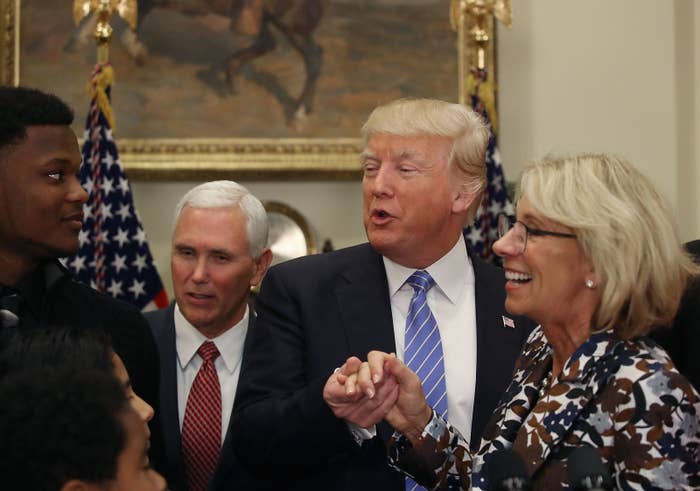
Deep cuts to the federal student loan program in the budget proposal President Trump plans to release Tuesday — some $143 billion over 10 years — would hit graduate students hard, increasing both their monthly loan payments and the time it takes for their loans to be forgiven.
Trump is also calling to end Public Service Loan Forgiveness, a federal program introduced by the Bush administration where loans for students who go on to work in government or for non-profits are forgiven after 10 years of income-based payments, instead of the current 20. The cut would not impact students who are already enrolled in income-based repayment.
Though the proposals would mean an increased burden for graduate students, it's less obvious what it would mean for undergraduates, who make up the vast majority of student loan borrowers. Some details of the proposed loan program were reported by the Washington Post last week.
The administration's proposals are essentially a wish list sent to Congress, and many pieces are not likely to pass.
Trump's budget also eventually eliminates the federally-subsidized Stafford loan program, which provides low-income students loans at lower interest rates — meaning many poor borrowers would be saddled with higher interest rates than they face now. The Trump budget offers no explanation for the cuts besides calling them "inefficient."
The proposal does, however, allows low-income undergraduates to use Pell Grants year-round, a longtime rallying cry of many left-wing advocates who say it is important for students who want to take extra summer classes and remedial courses.
Trump's budget proposal is an opening gambit in a long negotiation with Congress. The cuts to public service loan forgiveness and the elimination of subsidized loans, for example, may not make much headway in the House and Senate. But his income-based repayment plan could be enacted through an executive order.
Under the Trump plan, graduate students would have to pay 12.5% of their salaries for 30 years — a significant burden compared to the current Obama administration plan, under which they pay 10% of their income for just 25 years.
"It would be very rare for someone to have debt forgiven under [these] new terms," said Jason Delisle, a fellow at the right-leaning American Enterprise Institute. "Which should be the goal for graduate school debt."
Like graduate students, undergraduates will have to pay a higher percentage of their income every month than under the Obama administration's plan — 12.5% instead of 10%. But their loans would be forgiven after just 15 years of payments, instead of 20 — a significant difference for borrowers with high loan balances or people who make so little that they do not have to make monthly payments on government-subsidized student loans.
"Looking at the budget, it's pretty clear that the Trump administration is trying to help undergraduates," said Alexander Holt, an independent education consultant in Washington, D.C. "He's doing it with the savings from pulling back benefits from graduate students."
The difference between offering forgiveness at 15 and 20 years can be drastic, said Holt. "It can be an incredible thing for struggling borrowers," he said. "I'm still a little confused why nobody on the left is praising this."
But low-income borrowers would be hurt by the loss of the subsidized Stafford loan program, said Ben Miller, an analyst at the left-leaning Center for American Progress, who said the Stafford cuts are the "most worrisome" part of the budget proposal. It's unclear, Miller said, whether many borrowers would be better off making larger payments for a shorter term, as Trump's income-based plan envisions.
"There's not really any winners here," he said. "It's a question of who loses the most. Ultimately, what's being proposed here is to take tens of billions of dollars from the student loan program."
